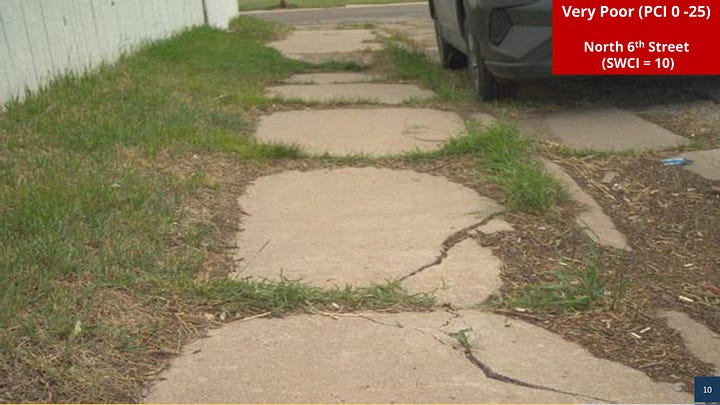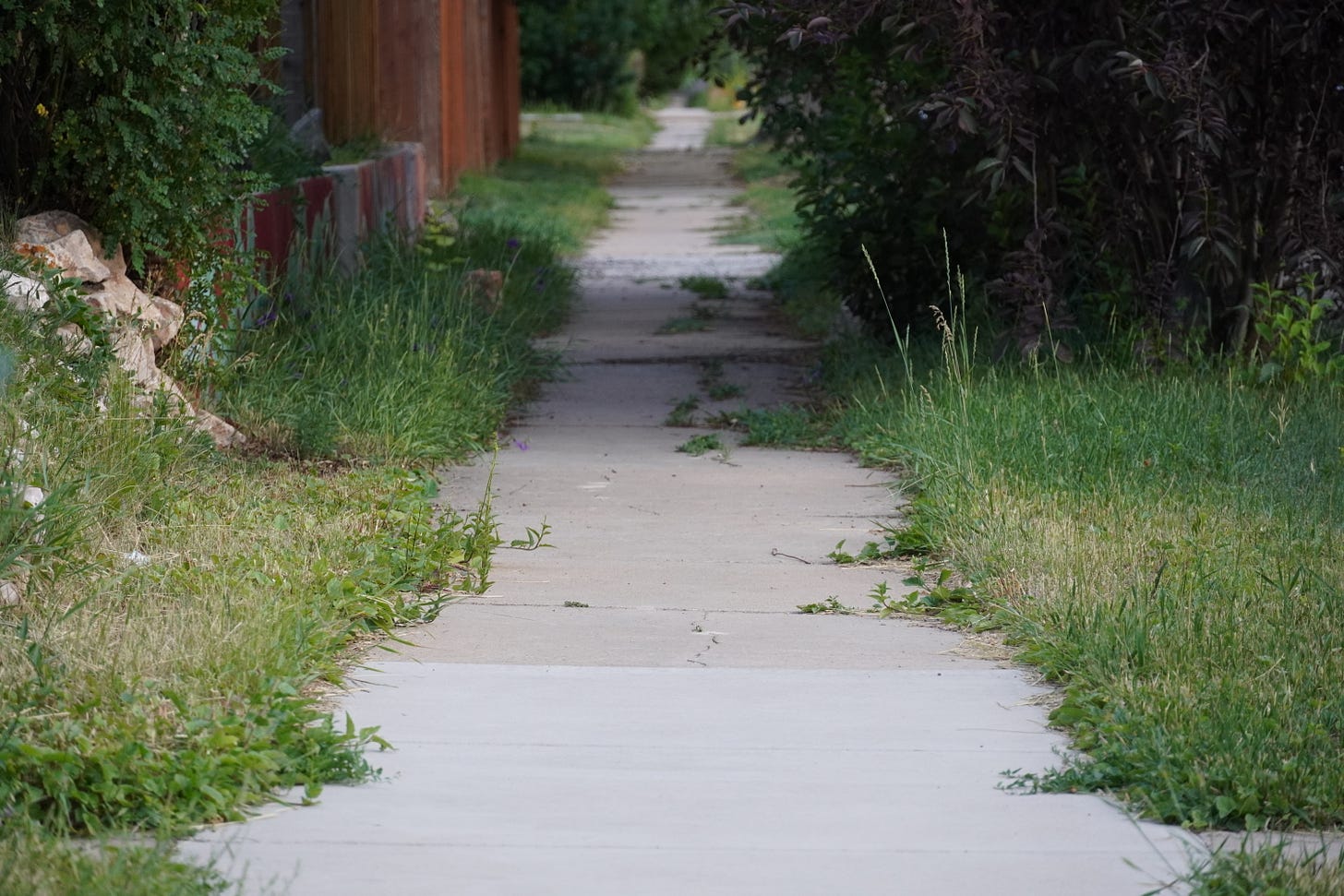Of Note: Laramie has 200 miles of sidewalk
A consulting firm recently assessed Laramie’s sidewalks, noting the city’s “pretty good” overall conditions, while highlighting a significant shortage of ramps.
Nearly 150 people voted in a poll shared yesterday to Twitter asking “How much sidewalk does Laramie have?” Most respondents underestimated the extent of Laramie’s sidewalks, with almost half guessing “0-50 miles.” About 23% correctly answered “100-500 miles.”
Laramie is home to 198.4 miles of sidewalk, covering a total land area of about 5.3 million square feet.
These figures were shared publicly during a Tuesday work session of the Laramie City Council.
At the meeting, councilors heard from Megan Ratliff, a private consultant who had evaluated the city’s network of sidewalks with a focus on overall accessibility.
Ratliff’s presentation assessed sidewalk conditions and conducted reviews of curb ramps and sidewalk hindrances before estimating what a full rehabilitation of Laramie’s street-side pathways might cost.
The Sidewalk Condition Index, which was developed by Ratliff’s company, gives each stretch of sidewalk a grade out of 100 based on the type, quantity and severity of the wear and tear on that stretch. The senior project engineer used LiDAR and other technologies to collect sidewalk elevation, slope, width and other relevant measurements to a high degree of accuracy.
In Laramie, nearly half of all sidewalks — 45.6% — are considered “good,” receiving a score in the top quartile (75-100 points).
Another 39.1% are considered “fair” while 15.6% are considered “poor.”
Just 1.7% of Laramie’s sidewalks are considered “very poor,” falling in the bottom quartile (0-25 points).
The average across Laramie is 68 points, according to the index.
“So on a scale of zero to 100, this is a pretty good number,” Ratliff said. “I don’t want to say, ‘Oh, this is good or bad.’ It’s very hard to keep the vast number of sidewalks in perfect condition. You’re never going to see a network where it’s in perfect condition.”
The presentation includes representative photos of each condition category.


Ratliff also categorized Laramie’s curb ramps into five levels of varying conformity.
“So Level 1 means that there are hardly any issues with the curb ramp, and then Level 5 means that there are several issues with the curb ramp,” Ratliff said. “But you'll notice there are no Level 5 in Laramie, so that is a good thing to note.”
But that doesn’t mean Laramie is in the clear, she added.
“There are a lot of instances where there is not a curb ramp, but there probably should be one,” Ratliff said, highlighting places where people are expected to cross. “If an individual in a wheelchair, or a visually impaired individual, would try to navigate from the sidewalk into the street or need to cross for whatever reason, they would potentially be impacted by that curb being in the way. So it’s not a smooth transition. There is no gradual slope that allows them to do so.”
Of the 4,461 locations throughout the city that should have a curb ramp, only 38% do, while a majority, 62%, do not.
Fixing all sidewalk distress, adding the missing ramps and removing hindrances would come with a steep price tag.
“The total estimated cost of rehabilitation for the entire network is about $32 million,” Ratliff said. “But I want to immediately caveat that and say that that is assuming that you were to fix every single segment in your network. Now, nobody ever is going to do that. There is just not enough funding to be able to fix every sidewalk in a 200 mile-long sidewalk network. That’s not realistic. That’s not feasible. No agency is going to take that on.”
But she said having the data will allow the city to plan appropriately and prioritize the most pressing issues.
“Maybe we can focus on the very severe issues, which we have noted,” Ratliff said. “So this just allows the city of Laramie to leverage the data in a way that allows them to really focus on the issues, the really big issues, the ones that residents will complain about, or just overall are a safety concern. But having this plan, having this estimate in place, gives a starting point for sure.”
Councilors do not take votes during work sessions, which are meant to be informational. However, several councilors discussed more aggressively enforcing city codes against sidewalk hindrances, and the possibility of setting up a public portal where residents can report obstructions.
“And then we can focus on that part of our 200 miles of sidewalks instead of trying to focus on 200 miles,” Councilor Joe Shumway said. “Maybe we could focus on a quarter mile or whatever we need to on improvements.”
Council goals for 2025 include making the city’s sidewalks and bike paths more accessible “for persons of all ages and abilities.”
Have you noticed anything mildly interesting around town? The sort of peculiarity that begs to be explained but is too small to make a fuss about? An idiosyncrasy you want to understand but you don’t know who to ask? Let us know in the comments below or via email to jeffvictorwyo@gmail.com and we might dig up an answer for the next installment of “Of Note.”






Laramie should also take a look at street gutters. The practice of layering on new asphalt without removing any of the old street surface has resulted in some gutters on older streets being almost a foot below street level. There's no hope of the street sweeper clearing these deep hazards. The consequent filling of gutters with tree debris severely reduces city walkability, especially for seniors and those who are vision impaired.
What Jeff does not mention is that the presentation received by Council seemed to be a sales pitch for a proposal to throw good money after bad. City staff is proposing to pay an additional $100,000 of taxpayer money toward an infrastructure survey project which was started BACK IN 2022 but has not been completed by the third party contractor.
The company which was supposed to complete the survey was busy wrapping up a big merger and acquisition, but didn't devote enough time over THREE YEARS to complete the job it was hired to do: surveying Laramie's sidewalks and streets for damage. Not even fixing them; just surveying them.
Shouldn't we be holding the contractor to the terms of the original contract? Also, since much of the work done since 2022 is likely to be obsolete (the condition of streets and sidewalks can change dramatically in 3 years, especially if there is flooding as there has been during that time), should we not be insisting that it be updated at no charge rather than throwing more money at them? And finally: Shouldn't we be constantly evaluating our own infrastructure rather than contracting the work out? At one time, we had a code inspector who walked every street and alley of Laramie, looking for weeds, trash, abandoned vehicles, and other nuisances as well as curbs, gutters, and sidewalks that needed work. Why is our in-house staff, whose salaries Council has recently voted to increase, not doing this now? Is it not their job to maintain our city's infrastructure, rather than spending taxpayer money to outsource it while they sit at their desks and collect some of the highest salaries in Laramie?